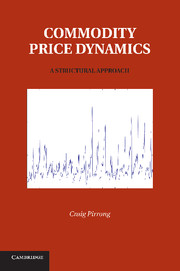Book contents
- Frontmatter
- Contents
- Preface
- 1 Introduction
- 2 The Basics of Storable Commodity Modeling
- 3 High-Frequency Price Dynamics for Continuously Produced Commodities in a Two-Factor Storage Economy: Implications for Derivatives Pricing
- 4 The Empirical Performance of the Two-Factor Storage Model
- 5 Stochastic Fundamental Volatility, Speculation, and Commodity Storage
- 6 The Pricing of Seasonal Commodities
- 7 The Dynamics of Carbon Markets
- 8 The Structural Modeling of Non-Storables: Electricity
- References
- Author Index
- Subject Index
7 - The Dynamics of Carbon Markets
Published online by Cambridge University Press: 05 June 2012
- Frontmatter
- Contents
- Preface
- 1 Introduction
- 2 The Basics of Storable Commodity Modeling
- 3 High-Frequency Price Dynamics for Continuously Produced Commodities in a Two-Factor Storage Economy: Implications for Derivatives Pricing
- 4 The Empirical Performance of the Two-Factor Storage Model
- 5 Stochastic Fundamental Volatility, Speculation, and Commodity Storage
- 6 The Pricing of Seasonal Commodities
- 7 The Dynamics of Carbon Markets
- 8 The Structural Modeling of Non-Storables: Electricity
- References
- Author Index
- Subject Index
Summary
Introduction
Carbon permits issued as part of cap-and-trade systems around the world, and derivatives thereon, are likely to become one of the world's largest commodity markets in the coming years. Virtually every economic activity involving the production or consumption of energy will be affected by cap and trade, and this system for controlling greenhouse gases will therefore entail the purchase and sale of large quantities of carbon permits and derivatives.
This raises the question: How will carbon prices behave? The answer to that question depends on the design of the carbon market, which points to one of the distinctive things about this commodity: its market will be one of our own design. Throughout this book, I have noted that storage decisions and, hence, commodity prices depend on characteristics of the commodity, such as the nature of production (is it seasonally produced or not?) and spatial factors (how easy is it to trade across space?). With most of the commodities we are familiar with, say wheat or copper, some of these factors are outside of human control. Fundamental natural factors make wheat a periodically produced commodity, and nothing humans can do will change that.
Things are quite different with carbon. It is possible to choose – to design – virtually all of the salient features of this commodity. For instance, the frequency of production can be determined by legislative fiat. The author of the laws establishing cap and trade can specify that the permits will be issued yearly, or monthly, or weekly, or whatever.
- Type
- Chapter
- Information
- Commodity Price DynamicsA Structural Approach, pp. 164 - 180Publisher: Cambridge University PressPrint publication year: 2011
- 3
- Cited by



